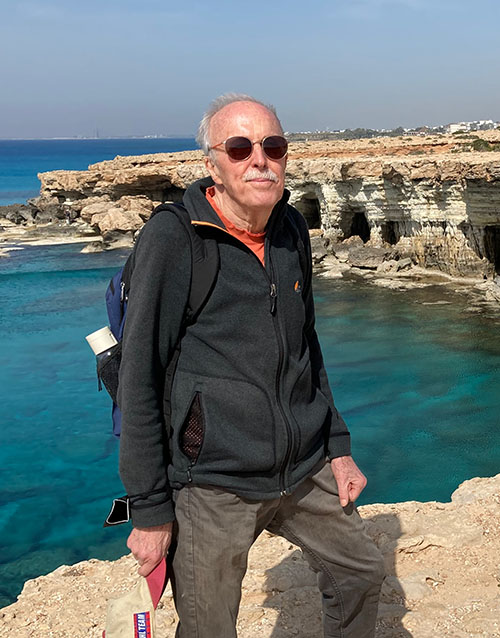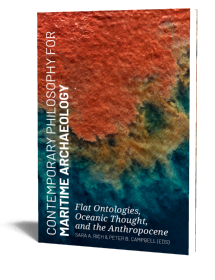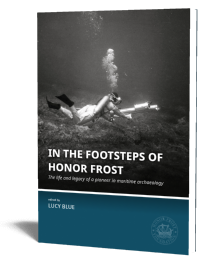Seafaring and Seafarers in the Bronze Age Eastern Mediterranean
A. Bernard Knapp | 2018

Seafaring and Seafarers in the Bronze Age Eastern Mediterranean
A. Bernard Knapp | 2018
Paperback ISBN: 9789088905544 | Hardback ISBN: 9789088905551 | Imprint: Sidestone Press | Format: 182x257mm | 298 pp. | Language: English | 40 illus. (bw) | 20 illus. (fc) | Keywords: seafaring, seafarers, seascapes, Bronze Age trade, eastern Mediterranean, connectivity, mobility, maritime archaeology, ships and shipwrecks, ports and harbours; Cyprus; Egypt; the Levant; Anatolia | download cover
Read online or downloaded 3829 times
-
Digital & Online access
This is a full Open Access publication, click below to buy in print, browse, or download for free.
-
Buy via Sidestone (EU & UK)
-
Buy via our Distributors (WORLD)
For non-EU or UK destinations you can buy our books via our international distributors. Although prices may vary this will ensure speedy delivery and reduction in shipping costs or import tax. But you can also order with us directly via the module above.
UK international distributor
USA international distributor
-
Bookinfo
Paperback ISBN: 9789088905544 | Hardback ISBN: 9789088905551 | Imprint: Sidestone Press | Format: 182x257mm | 298 pp. | Language: English | 40 illus. (bw) | 20 illus. (fc) | Keywords: seafaring, seafarers, seascapes, Bronze Age trade, eastern Mediterranean, connectivity, mobility, maritime archaeology, ships and shipwrecks, ports and harbours; Cyprus; Egypt; the Levant; Anatolia | download cover
Read online or downloaded 3829 times

We will plant a tree for each order containing a paperback or hardback book via OneTreePlanted.org.
Seafaring is a mode of travel, a way to traverse maritime space that enables not only the transport of goods and materials but also of people and ideas — communicating and sharing knowledge across the sea and between different lands. Seagoing ships under sail were operating between the Levant, Egypt, Cyprus and Anatolia by the mid-third millennium BC and within the Aegean by the end of that millennium. By the Late Bronze Age (after ca. 1700/1600 BC), seaborne trade in the eastern Mediterranean made the region an economic epicentre, one in which there was no place for Aegean, Canaanite or Egyptian trading monopolies, or ‘thalassocracies’. At that time, the world of eastern Mediterranean seafaring and seafarers became much more complex, involving a number of different peoples in multiple networks of economic and social exchange.
This much is known, or in many cases widely presumed. Is it possible to trace the origins and emergence of these early trade networks? Can we discuss at any reasonable level who was involved in these maritime ventures? Who built the early ships in which maritime trade was conducted, and who captained them? Who sailed them? Which ports and harbours were the most propitious for maritime trade? What other evidence exists for seafaring, fishing, the exploitation of marine resources and related maritime matters?
This study seeks to address such questions by examining a wide range of material, documentary and iconographic evidence, and re-examining a multiplicity of varying interpretations on Bronze Age seafaring and seafarers in the eastern Mediterranean, from Anatolia in the north to Egypt in the south and west to Cyprus. The Aegean world operated on the western boundaries of this region, but is referred to more in passing than in engagement. Because the social aspects of seafaring and transport, the relationship different peoples had with the sea, and the whole notion of ‘seascapes’ are seldom discussed in the literature of the eastern Mediterranean Bronze Age, this volume devotes significant attention to such factors, including: mobility, connectivity, the length and purpose as well as the risk of the journey, the knowledge and experience of navigation and travel, ‘working’ the sea, the impact of distance and access to the exotic upon peoples’ identities and ideologies, and much more.
Preface and Acknowledgements
List of Figures
1. Introduction
A Brief (Pre)History of the Mediterranean Bronze Age
2. Maritime Matters and Materials
Social Aspects
– Seascapes and Seafaring
– Merchants, Mariners and Pirates
Material Aspects
– Shipwrecks
– Ports and Harbours
– Maritime Transport Containers (MTCs)
– Ships’ Representations, Boat Models
– Stone Anchors, Fishing and Fishing Equipment
3. Early Bronze Age
The Levant and Egypt
– Ports and Harbours
– Ships’ Representations
– Maritime Transport Containers (MTCs)
– Stone Anchors
Cyprus
Anatolia
– Ports and Harbours
4. Middle Bronze Age
The Levant and Egypt
– Ports and Harbours
– Ships’ Representations
– Maritime Transport Containers (MTCs)
– Stone Anchors
Cyprus
– Ships’ Representations
– Maritime Transport Containers and Overseas Trade
Anatolia
– Shipwrecks and Stone Anchors
– Ports and Harbours
– Maritime Transport Containers
5. Late Bronze Age
The Documentary Record
– Ships and Cargoes
– Merchants and Mariners
The Levant and Egypt
– Ports and Harbours
– Ships’ Representations (Levant)
– Ships’ Representations (Egypt)
– Maritime Transport Containers (MTCs)
– Stone Anchors, Fishing Tackle and Fish
Cyprus
– Harbours
– Ships’ Representations
– Maritime Transport Containers (MTCs)
– Stone Anchors
– Miniature Anchors, Fishing Tackle and Fish
Anatolia
– Harbours
– Shipwrecks
– Ships’ Representations
– Stone Anchors and Fishing Equipment
6. Seafaring, Seafarers and Seaborne Trade
A Diachronic Overview
– Early Bronze Age
– Middle Bronze Age
– Late Bronze Age
Networks and Routes of Exchange
Seafaring, Seafarers and Bronze Age Polities
7. Conclusions
8. References
9. Index

Professor A. Bernard Knapp
A. Bernard Knapp is Emeritus Professor of Mediterranean Archaeology in the Department of Humanities (Archaeology), University of Glasgow, and Honorary Research Fellow, Cyprus American Archaeological Research Institute, Nicosia. His research interests focus on the prehistoric Mediterranean, especially Cyprus, on maritime archaeology, and on various aspects of archaeological theory, including mobility and connectivity, and social identity.
He is the author and editor of several books including, most recently, Seafaring and Seafarers in the Bronze Age Eastern Mediterranean (Leiden, Sidestone Press, 2018), Migration Myths and the End of the Bronze Age in the Eastern Mediterranean (New York, Cambridge University Press, 2021) and Late Bronze Age Cyprus: A Reassessment of Settlement Structure and Society (Nicosia: Astrom Editions, 2023).
Abstract:
Seafaring is a mode of travel, a way to traverse maritime space that enables not only the transport of goods and materials but also of people and ideas — communicating and sharing knowledge across the sea and between different lands. Seagoing ships under sail were operating between the Levant, Egypt, Cyprus and Anatolia by the mid-third millennium BC and within the Aegean by the end of that millennium. By the Late Bronze Age (after ca. 1700/1600 BC), seaborne trade in the eastern Mediterranean made the region an economic epicentre, one in which there was no place for Aegean, Canaanite or Egyptian trading monopolies, or ‘thalassocracies’. At that time, the world of eastern Mediterranean seafaring and seafarers became much more complex, involving a number of different peoples in multiple networks of economic and social exchange.
This much is known, or in many cases widely presumed. Is it possible to trace the origins and emergence of these early trade networks? Can we discuss at any reasonable level who was involved in these maritime ventures? Who built the early ships in which maritime trade was conducted, and who captained them? Who sailed them? Which ports and harbours were the most propitious for maritime trade? What other evidence exists for seafaring, fishing, the exploitation of marine resources and related maritime matters?
This study seeks to address such questions by examining a wide range of material, documentary and iconographic evidence, and re-examining a multiplicity of varying interpretations on Bronze Age seafaring and seafarers in the eastern Mediterranean, from Anatolia in the north to Egypt in the south and west to Cyprus. The Aegean world operated on the western boundaries of this region, but is referred to more in passing than in engagement. Because the social aspects of seafaring and transport, the relationship different peoples had with the sea, and the whole notion of ‘seascapes’ are seldom discussed in the literature of the eastern Mediterranean Bronze Age, this volume devotes significant attention to such factors, including: mobility, connectivity, the length and purpose as well as the risk of the journey, the knowledge and experience of navigation and travel, ‘working’ the sea, the impact of distance and access to the exotic upon peoples’ identities and ideologies, and much more.
Contents
Preface and Acknowledgements
List of Figures
1. Introduction
A Brief (Pre)History of the Mediterranean Bronze Age
2. Maritime Matters and Materials
Social Aspects
– Seascapes and Seafaring
– Merchants, Mariners and Pirates
Material Aspects
– Shipwrecks
– Ports and Harbours
– Maritime Transport Containers (MTCs)
– Ships’ Representations, Boat Models
– Stone Anchors, Fishing and Fishing Equipment
3. Early Bronze Age
The Levant and Egypt
– Ports and Harbours
– Ships’ Representations
– Maritime Transport Containers (MTCs)
– Stone Anchors
Cyprus
Anatolia
– Ports and Harbours
4. Middle Bronze Age
The Levant and Egypt
– Ports and Harbours
– Ships’ Representations
– Maritime Transport Containers (MTCs)
– Stone Anchors
Cyprus
– Ships’ Representations
– Maritime Transport Containers and Overseas Trade
Anatolia
– Shipwrecks and Stone Anchors
– Ports and Harbours
– Maritime Transport Containers
5. Late Bronze Age
The Documentary Record
– Ships and Cargoes
– Merchants and Mariners
The Levant and Egypt
– Ports and Harbours
– Ships’ Representations (Levant)
– Ships’ Representations (Egypt)
– Maritime Transport Containers (MTCs)
– Stone Anchors, Fishing Tackle and Fish
Cyprus
– Harbours
– Ships’ Representations
– Maritime Transport Containers (MTCs)
– Stone Anchors
– Miniature Anchors, Fishing Tackle and Fish
Anatolia
– Harbours
– Shipwrecks
– Ships’ Representations
– Stone Anchors and Fishing Equipment
6. Seafaring, Seafarers and Seaborne Trade
A Diachronic Overview
– Early Bronze Age
– Middle Bronze Age
– Late Bronze Age
Networks and Routes of Exchange
Seafaring, Seafarers and Bronze Age Polities
7. Conclusions
8. References
9. Index

Professor A. Bernard Knapp
A. Bernard Knapp is Emeritus Professor of Mediterranean Archaeology in the Department of Humanities (Archaeology), University of Glasgow, and Honorary Research Fellow, Cyprus American Archaeological Research Institute, Nicosia. His research interests focus on the prehistoric Mediterranean, especially Cyprus, on maritime archaeology, and on various aspects of archaeological theory, including mobility and connectivity, and social identity.
He is the author and editor of several books including, most recently, Seafaring and Seafarers in the Bronze Age Eastern Mediterranean (Leiden, Sidestone Press, 2018), Migration Myths and the End of the Bronze Age in the Eastern Mediterranean (New York, Cambridge University Press, 2021) and Late Bronze Age Cyprus: A Reassessment of Settlement Structure and Society (Nicosia: Astrom Editions, 2023).
-
Digital & Online access
This is a full Open Access publication, click below to buy in print, browse, or download for free.
-
Buy via Sidestone (EU & UK)
-
Buy via our Distributors (WORLD)
For non-EU or UK destinations you can buy our books via our international distributors. Although prices may vary this will ensure speedy delivery and reduction in shipping costs or import tax. But you can also order with us directly via the module above.
UK international distributor
USA international distributor
- Browse all books by subject
-
Search all books

We will plant a tree for each order containing a paperback or hardback book via OneTreePlanted.org.
You might also like:
© 2025 Sidestone Press KvK nr. 28114891 Privacy policy Sidestone Newsletter Terms and Conditions (Dutch)








